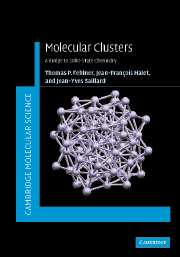Book contents
- Frontmatter
- Contents
- Preface
- 1 Introduction
- 2 Main-group clusters: geometric and electronic structure
- 3 Transition-metal clusters: geometric and electronic structure
- 4 Isolobal relationships between main-group and transition-metal fragments. Connections to organometallic chemistry
- 5 Main-group–transition-metal clusters
- 6 Transition to the solid state
- 7 From molecules to extended solids
- 8 Inter-conversion of clusters and solid-state materials
- Appendix: Fundamental concepts: a concise review
- Problem Answers
- References
- Index
- References
1 - Introduction
Published online by Cambridge University Press: 19 February 2010
- Frontmatter
- Contents
- Preface
- 1 Introduction
- 2 Main-group clusters: geometric and electronic structure
- 3 Transition-metal clusters: geometric and electronic structure
- 4 Isolobal relationships between main-group and transition-metal fragments. Connections to organometallic chemistry
- 5 Main-group–transition-metal clusters
- 6 Transition to the solid state
- 7 From molecules to extended solids
- 8 Inter-conversion of clusters and solid-state materials
- Appendix: Fundamental concepts: a concise review
- Problem Answers
- References
- Index
- References
Summary
A modern chemist has access to good computational methods that generate numerically useful information on molecules, e.g., energy, geometry and vibrational frequencies. But we also have a collection of models based on orbital ideas incorporating concepts of symmetry, overlap and electronegativity. In this text we focus on the latter as these ideas have been a huge aid in understanding the connections between stoichiometry, geometry and electronic structure. The connections can be as simple as an electron count yielding user-friendly “rules.” Our problem here, the electronic structure of a cluster or a more extended structure of the type encountered in solid-state chemistry, requires the application of models beyond those reviewed in the Appendix. Models are like tools – they permit us to disassemble and assemble the electronic structure of molecules. For each problem we choose a model that will accomplish the task with minimum effort and maximum understanding. Just as one would not use a screwdriver to remove a hex nut, so too we cannot use highly localized models to usefully describe the electronic structures of many clusters and extended bonding systems. We must use a method that is capable of producing a sensible solution as well as one that is sufficiently versatile to treat both the bonding in small clusters and bulk materials.
The proven method we will use is one that generates solutions based on the orbitals and electrons that the atoms or molecular fragments bring to the problem.
- Type
- Chapter
- Information
- Molecular ClustersA Bridge to Solid-State Chemistry, pp. 1 - 32Publisher: Cambridge University PressPrint publication year: 2007

